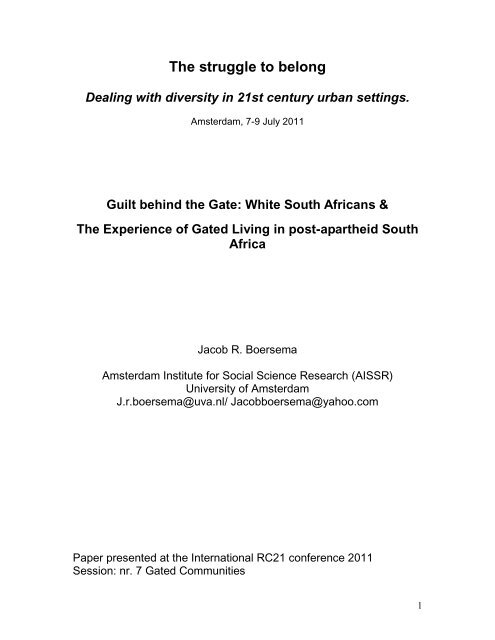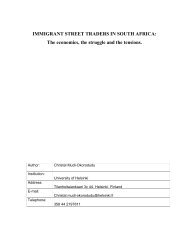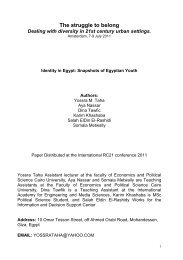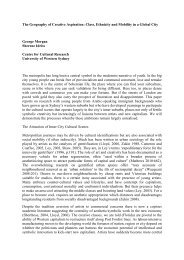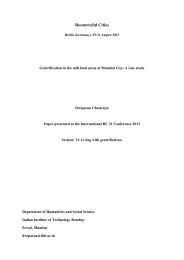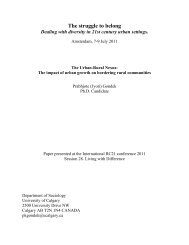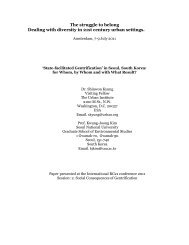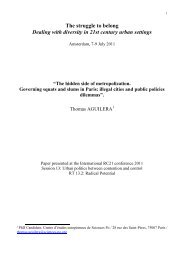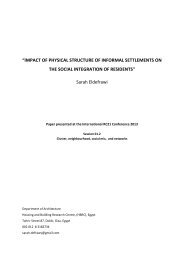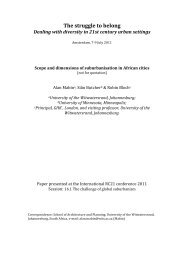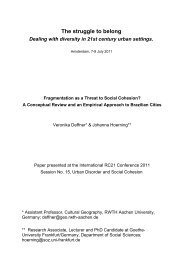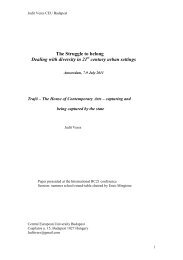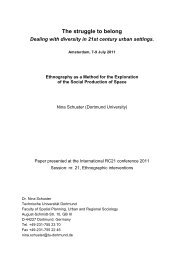White South Africans & The Experience of Gated Living in post ...
White South Africans & The Experience of Gated Living in post ...
White South Africans & The Experience of Gated Living in post ...
You also want an ePaper? Increase the reach of your titles
YUMPU automatically turns print PDFs into web optimized ePapers that Google loves.
<strong>The</strong> struggle to belong<br />
Deal<strong>in</strong>g with diversity <strong>in</strong> 21st century urban sett<strong>in</strong>gs.<br />
Amsterdam, 7-9 July 2011<br />
Guilt beh<strong>in</strong>d the Gate: <strong>White</strong> <strong>South</strong> <strong>Africans</strong> &<br />
<strong>The</strong> <strong>Experience</strong> <strong>of</strong> <strong>Gated</strong> <strong>Liv<strong>in</strong>g</strong> <strong>in</strong> <strong>post</strong>-apartheid <strong>South</strong><br />
Africa<br />
Jacob R. Boersema<br />
Amsterdam Institute for Social Science Research (AISSR)<br />
University <strong>of</strong> Amsterdam<br />
J.r.boersema@uva.nl/ Jacobboersema@yahoo.com<br />
Paper presented at the International RC21 conference 2011<br />
Session: nr. 7 <strong>Gated</strong> Communities<br />
1
1.1 Introduction<br />
This paper addresses the question <strong>of</strong> how liv<strong>in</strong>g <strong>in</strong> a gated community is experienced by<br />
white Afrikaans women <strong>in</strong> <strong>South</strong> Africa. In the literature on neoliberal urban<br />
development, gat<strong>in</strong>g as a new development is <strong>of</strong>ten critically exam<strong>in</strong>ed because <strong>of</strong> its<br />
associated with issues such as privatization, fear <strong>of</strong> crime, racism, and the cont<strong>in</strong>uity <strong>of</strong><br />
white economic privilege (Blakely and Snyder 1997; Caldeira 2000; Low 2003). But do<br />
these different issues connect? And if so: how? That is <strong>of</strong>ten left unclear <strong>in</strong> the literature.<br />
Authors that have focused on such questions <strong>of</strong>ten use psychoanalytic theories to expla<strong>in</strong><br />
the strong emotions <strong>in</strong>volved <strong>in</strong> gat<strong>in</strong>g. But what k<strong>in</strong>d <strong>of</strong> new emotional landscape do<br />
gated communities create? Do such communities contribute to a fear <strong>of</strong> crime and fear <strong>of</strong><br />
the racial other, and if so, how? <strong>The</strong>se are the questions I will address <strong>in</strong> this paper and<br />
first explore <strong>in</strong> this theoretical <strong>in</strong>troduction.<br />
<strong>The</strong> phenomenon <strong>of</strong> gated communities has been extensively debated <strong>in</strong> the United States<br />
and more recently also <strong>in</strong> such countries as Ch<strong>in</strong>a, Brazil, and Turkey (Duncan and<br />
Duncan 2001; Duncan and Duncan 2004; Genis 2007; Glasze, Webster and Frantz 2006;<br />
Soja 2000; Wu and Webber 2004). Researchers have variously emphasized the legal,<br />
economic, architectural and life-style aspects <strong>of</strong> this trend. i <strong>Gated</strong> communities are <strong>of</strong>ten<br />
presented as the summon <strong>of</strong> neoliberal urban development and the trend <strong>of</strong> privatization<br />
and securitization. By def<strong>in</strong>ition, they are founded on a territorial, material basis that<br />
privatizes landscape through various mechanisms <strong>of</strong> appropriation and exclusion, private<br />
(<strong>in</strong>clud<strong>in</strong>g <strong>in</strong>stitutional) ownership, and local legislation (Low 2001).<br />
S<strong>in</strong>ce the abolishment <strong>of</strong> apartheid the gat<strong>in</strong>g <strong>of</strong> streets and communities has also<br />
exploded <strong>in</strong> <strong>South</strong> Africa. In the <strong>South</strong> African context, gat<strong>in</strong>g is also <strong>of</strong>ten discussed <strong>in</strong><br />
critical terms: it would symbolize the failure <strong>of</strong> racial <strong>in</strong>tegration and the cont<strong>in</strong>uity <strong>of</strong><br />
white racism and white privilege after apartheid. Like <strong>in</strong> the rest <strong>of</strong> the world, security<br />
estates have emerged driven by complex forces that have to do with security concerns,<br />
real estate values, the f<strong>in</strong>anc<strong>in</strong>g <strong>of</strong> real estate, a search for community and identity, and<br />
the <strong>in</strong>tegration <strong>of</strong> liv<strong>in</strong>g and well-be<strong>in</strong>g, <strong>in</strong>clud<strong>in</strong>g sport facilities and nature areas. <strong>The</strong><br />
trend has been documented <strong>in</strong> most major cities like Cape Town, Durban and<br />
Johannesburg, and has even been compared between cities (Ballard 2002; Beall,<br />
Crankshaw and Parnell 2002; Besteman 2008; Jürgens and Gnad 2002; Lemanski,<br />
Landman and Dur<strong>in</strong>gton 2008). Surpris<strong>in</strong>gly, maybe, the political capital Pretoria, the<br />
location <strong>of</strong> Golden Sun Estate, has been left unexam<strong>in</strong>ed. Moreover, few <strong>of</strong> these studies<br />
have actually addressed what it is like to live <strong>in</strong> a gated community.<br />
1.2 <strong>The</strong> <strong>Experience</strong> <strong>of</strong> <strong>Gated</strong> <strong>Liv<strong>in</strong>g</strong><br />
<strong>The</strong> choice to live <strong>in</strong> a gated community for white residents is <strong>of</strong>ten depicted as an<br />
emotional one. Fear <strong>of</strong> crime and fear <strong>of</strong> otherness would play a large role <strong>in</strong> the life and<br />
residential choices <strong>of</strong> residents. In her study <strong>of</strong> gated communities <strong>in</strong> America,<br />
anthropologist Setha Low focuses specifically on the relationships between gat<strong>in</strong>g and<br />
emotions (Low 2001; 2008; 2003). Low even speaks <strong>of</strong> a new ‗structure <strong>of</strong> feel<strong>in</strong>g‘<br />
created by these urban developments (Low 2008). In her detailed anthropological work,<br />
she dissects the different emotional concerns mostly white residents have about crime,<br />
2
community, and the desire for safety <strong>in</strong> America. One way she discovered <strong>in</strong> which white<br />
residents assuage their anxieties about race and crime is by polic<strong>in</strong>g the ‗niceness‘ <strong>of</strong><br />
other residents. <strong>The</strong> norm <strong>of</strong> ‗niceness‘ is a generic descriptor white residents use for<br />
what is judged as normal appearance and behavior. Low connects the construction <strong>of</strong><br />
‗niceness‘ to whiteness and contrast it to the ‗fear <strong>of</strong> others.‘ Norms <strong>in</strong> the social<br />
environment, she writes, ―act to naturalize the cultural preferences and codes <strong>of</strong> white<br />
privilege‖ and assuage the anxieties <strong>of</strong> white middle class.<br />
In her analysis <strong>of</strong> the different emotions residents experience, Low uses a psychoanalytic<br />
framework to expla<strong>in</strong> the experience <strong>of</strong> liv<strong>in</strong>g <strong>in</strong> gated communities. She builds on a<br />
small tradition <strong>in</strong> urban geography that has pioneered psychoanalytic accounts <strong>of</strong> the<br />
experience <strong>of</strong> space (Sennett 2008; Sibley 1995). <strong>South</strong> African researchers have also<br />
written <strong>in</strong> a psychoanalytic register. Bremner, for <strong>in</strong>stance, <strong>in</strong> her explanation <strong>of</strong> the<br />
phenomenon <strong>of</strong> gat<strong>in</strong>g argues that the impact <strong>of</strong> crime on the psyche <strong>of</strong> white <strong>South</strong><br />
<strong>Africans</strong> has the effect that (Bremner 2004):<br />
Ambiguities are elim<strong>in</strong>ated, new boundaries created and new social identities and certa<strong>in</strong>ties<br />
constructed (…) Crime provides a generative symbolism with which to talk about contemporary<br />
experiences perceived as alien, threaten<strong>in</strong>g, chaotic or bad – a black majority government ,<br />
deteriorat<strong>in</strong>g social services, dysfunctional traffic lights, a disloyal domestic worker etc. Through<br />
the experience <strong>of</strong> crime, uncomfortable processes <strong>of</strong> social change are coded and defensive<br />
mechanisms and projections aga<strong>in</strong>st them mobilized. Terror becomes the trope through which the<br />
transition is lived and made sense <strong>of</strong>.‖<br />
Bremner argues that the crim<strong>in</strong>al <strong>of</strong>fers a new imag<strong>in</strong>ary through which to establish<br />
cont<strong>in</strong>uity between the certa<strong>in</strong>ties <strong>of</strong> the past, the uncerta<strong>in</strong>ties <strong>of</strong> the present and the<br />
unknown-ness <strong>of</strong> the future. <strong>The</strong> wall <strong>of</strong> the gated community is the central figure <strong>of</strong> the<br />
new political order (Bremner 2004).<br />
<strong>The</strong>oretically, both Low and Bremner rely on the work <strong>of</strong> psychoanalyst Kle<strong>in</strong> to expla<strong>in</strong><br />
what they see as the contradictory values embodied by gated communities and the<br />
dom<strong>in</strong>ance <strong>of</strong> ‗terror‘ <strong>in</strong> the experience <strong>of</strong> whites. ii <strong>The</strong>y argue that racial anxieties and<br />
racialized fears about crime are so dom<strong>in</strong>ant among white residents that they have to rely<br />
on ‗code‘ to speak about their emotional experiences. In other words, that gat<strong>in</strong>g and fear<br />
<strong>of</strong> crime really stand <strong>in</strong> for someth<strong>in</strong>g else: racism. This is also the view <strong>of</strong> Lemanski. In<br />
a series <strong>of</strong> studies, mostly <strong>in</strong> and around Cape Town, Lemanski researched the residential<br />
strategies and social experience <strong>of</strong> crime among whites (Lemanski 2004; 2006a; 2006b;<br />
2006c). She shows how white residents <strong>in</strong> gated communities <strong>of</strong>ten mix fears <strong>of</strong> crime<br />
with broader fears regard<strong>in</strong>g the future <strong>of</strong> their western lifestyles <strong>in</strong> the new <strong>South</strong> Africa.<br />
Most whites, at least from 2003, did no longer feel safe <strong>in</strong> their residential area. In her<br />
research, Lemanski endorses the view that discourses on crime among whites are an<br />
acceptable discourse that serves as a code or pretext for talk about racist fears and ‗the<br />
other.‘<br />
In their approach, Low, Bremner, and Lemanski suggest that gated estates still function<br />
as historic urban communities with close social relationships, and that white residents<br />
have to talk <strong>in</strong> code to keep other groups/races out. Although it is misguided to suggest<br />
racism is not present, the question is do white elites really need such ‗racial cod<strong>in</strong>g‘ to<br />
3
assert their power? And consequently, do we need psychoanalytical theories to expla<strong>in</strong><br />
the emotional landscape <strong>of</strong> gated communities? I argue that if we are to understand how<br />
the new cultural landscape <strong>of</strong> neoliberal urbanism <strong>in</strong> <strong>South</strong> Africa is created and relates to<br />
the emotional experience <strong>of</strong> liv<strong>in</strong>g, crime and race, we first have to ask ourselves how<br />
economic elites relate to gat<strong>in</strong>g: what does it do for them?<br />
1.3 Expla<strong>in</strong><strong>in</strong>g <strong>Experience</strong>: Aestheticization, Emotions and<br />
Community<br />
<strong>Gated</strong> communities have been, at least <strong>in</strong>itially, an upper class and elite phenomenon <strong>in</strong><br />
<strong>South</strong> Africa and elsewhere. It is thus a development closely l<strong>in</strong>ked to the politics <strong>of</strong><br />
space by the affluent. As Harvey notes, elites are generally economically self-sufficient;<br />
they do not need to command space through cont<strong>in</strong>uous appropriation and neither do they<br />
need street-level <strong>in</strong>terpersonal relations and neighborhood networks <strong>in</strong> order to meet their<br />
basic needs. Instead, their common <strong>in</strong>terests and concerns generally revile around a need<br />
to ma<strong>in</strong>ta<strong>in</strong> the standards and property value <strong>of</strong> the built environment through a shared<br />
commitment to common conceptions <strong>of</strong> taste, aesthetic appreciation, and symbolic and<br />
cultural capital (1985: 262). Aestheticization thus becomes the preferred management<br />
technique <strong>of</strong> elites and this goes hand <strong>in</strong> hand with social exclusion and the management<br />
<strong>of</strong> class. As the rich try to simultaneously enhance, naturalize and conceal class privilege,<br />
aestheticization plays an important role <strong>in</strong> depoliticiz<strong>in</strong>g class relations (Harvey 2004).<br />
Duncan and Duncan beautifully illustrate how this operates <strong>in</strong> practice (Duncan and<br />
Duncan 2001; 2004). In their study <strong>of</strong> the aesthetic attitudes <strong>of</strong> residents <strong>in</strong> a semi-rural<br />
suburb <strong>of</strong> New York they show the <strong>in</strong>timate relationship between landscapes, social<br />
identity, and exclusion. <strong>The</strong>y show the important (new) role <strong>of</strong> aesthetic discourses <strong>in</strong><br />
support<strong>in</strong>g class <strong>in</strong>terests. Discourses <strong>of</strong> romantic ideology, localism, anti-urbanism, and<br />
anti-modernism mediate for residents the active role landscapes plays ―<strong>in</strong> the<br />
performance <strong>of</strong> elite social identities and the fram<strong>in</strong>g <strong>of</strong> social life and values with<strong>in</strong> a<br />
community.‖ (Duncan and Duncan 2001) People‘s aesthetic dispositions are related to<br />
ideology <strong>in</strong> that they refer to ―the unarticulated, unmediated, and naturalized pleasure<br />
one takes <strong>in</strong> the concrete materiality <strong>of</strong> th<strong>in</strong>gs <strong>in</strong> themselves‖ (Duncan and Duncan 2001).<br />
Particularly among the elite, landscapes and aesthetic dispositions are markers <strong>of</strong> identity.<br />
As such, they provoke s<strong>in</strong>cere emotions which <strong>in</strong>advertently act to naturalize class<br />
privileges and tastes. iii<br />
If we translate their f<strong>in</strong>d<strong>in</strong>gs to the study <strong>of</strong> private gated communities, we f<strong>in</strong>d that what<br />
matters for the experience <strong>of</strong> liv<strong>in</strong>g to elites is not so much social relationships but rather<br />
privacy, access and flexible associations <strong>of</strong> friendships and lifestyle (Blokland-Potters<br />
2003). iv Moreover, the ‗imag<strong>in</strong>ed‘ communities exist through shared memories <strong>of</strong> the<br />
past (images that <strong>of</strong>ten do not <strong>in</strong>clude m<strong>in</strong>orities). <strong>Gated</strong> communities are not def<strong>in</strong>ed by<br />
the social <strong>in</strong>teractions with<strong>in</strong> the community but by the emotional <strong>in</strong>volvement <strong>of</strong><br />
residents. American philosopher Margaret Kohn argues that communities are formed by<br />
<strong>in</strong>dividuals that identify with a particular location. Such groups, she writes, are<br />
―susta<strong>in</strong>ed by perceived similarities <strong>in</strong> lifestyle and absence <strong>of</strong> conflict… re<strong>in</strong>forced by<br />
similar patterns <strong>of</strong> consumption and cultural cues rather than shared activities and<br />
practices‖ (Kohn 2004). For Kohn, the aesthetic experience <strong>of</strong> liv<strong>in</strong>g <strong>in</strong> a neighborhood<br />
4
ecomes the basis <strong>of</strong> collective identity and belong<strong>in</strong>g, as the irreconcilable social<br />
antagonisms that pervade modern life are avoided. <strong>The</strong> effects <strong>of</strong> this aestheticization and<br />
privatization are multiple: to enhance the aesthetic experience <strong>of</strong> those groups deemed<br />
deserv<strong>in</strong>g; the use <strong>of</strong> space gets restricted to prevent the sight and proximity <strong>of</strong> (racial)<br />
others; the presence and speech <strong>of</strong> strangers becomes def<strong>in</strong>ed as an <strong>in</strong>convenience; the<br />
rights are removed <strong>of</strong> the undeserv<strong>in</strong>g and unwashed.<br />
A central place for aestheticization <strong>in</strong> the analysis <strong>of</strong> the experience <strong>of</strong> liv<strong>in</strong>g <strong>in</strong> gated<br />
communities suggests that elites do not need to speak <strong>in</strong> (racial) code to assert their<br />
(racial) power or (racial) hegemony. <strong>Gated</strong> community should be understood as the<br />
<strong>in</strong>stitutionalization and bureaucratization <strong>of</strong> taste. <strong>The</strong> myth that such communities are<br />
built around the sensuous, passionate, apparently autonomous subjective experience <strong>of</strong><br />
<strong>in</strong>dividuals - be it related to fear, terror or hate <strong>of</strong> the other – should be punctured. What<br />
is more, accord<strong>in</strong>g to the aesthetic logic it is not social relationships that matter for<br />
community but the aesthetic imag<strong>in</strong>ation <strong>of</strong> belong<strong>in</strong>g: the emotional experiences <strong>of</strong><br />
residents that are rooted <strong>in</strong> the historic and aesthetic conception <strong>of</strong> community. In<br />
contrast to psychoanalytic accounts, such an approach suggests that ‗cod<strong>in</strong>g‘ is not<br />
necessary to mask racism for white residents, just as racism is no longer necessary for<br />
exclusion or dom<strong>in</strong>ation. <strong>The</strong> connection between neoliberalism and aestheticization<br />
foregrounds choice and consumption, which makes redundant the cont<strong>in</strong>uation <strong>of</strong> the<br />
more virulent racialized politics <strong>of</strong> the past. v<br />
A short note on the methods <strong>of</strong> this study: as Dupuis and Thorns argue, most studies <strong>of</strong><br />
home and liv<strong>in</strong>g tend to be formalistic <strong>in</strong> their analysis rather than be<strong>in</strong>g based around<br />
first-hand accounts <strong>of</strong> people‘s actual lived experiences (Dupuis 1998). This study takes a<br />
different approach. In the case study <strong>of</strong> Golden Sun presented below, my focus is on the<br />
mean<strong>in</strong>g <strong>of</strong> gated liv<strong>in</strong>g for white Afrikaans female residents and how it reshapes their<br />
experiences <strong>of</strong> crime, race, and community. <strong>The</strong> study is based on three months <strong>of</strong><br />
residence <strong>in</strong> the community and participatory observations, and over forty <strong>in</strong>terviews<br />
with residents, employees and the management staff. vi From the many <strong>in</strong>terviews I did, I<br />
focus on the women <strong>in</strong> this paper because I found them particular articulate about their<br />
aesthetic concerns and few <strong>of</strong> them showed racism <strong>in</strong> the traditional sense. Before I<br />
analyze the discourses <strong>of</strong> the women, I first discuss the governance <strong>of</strong> the community.<br />
1.3 Three Views <strong>of</strong> Golden Sun Estate<br />
Golden Sun is one <strong>of</strong> the oldest and most prestigious security estates <strong>in</strong> Pretoria. With<br />
little more then a thousand households today, and six thousand <strong>in</strong>habitants <strong>in</strong> 2010, it has<br />
become a small city by itself. Orig<strong>in</strong>ally, the estate was built <strong>in</strong> 1990 at the eastern<br />
fr<strong>in</strong>ges <strong>of</strong> Pretoria as a life-style community around a gold course. S<strong>in</strong>ce then, however, it<br />
has expanded to more then triples its size. <strong>The</strong> last ten years the East rand <strong>of</strong> Pretoria has<br />
experienced an explosion <strong>in</strong> urban developments; the area has attracted other gated<br />
communities and a lot <strong>of</strong> commercial development. Today, Golden Sun is no longer an<br />
isolated security estate but part <strong>of</strong> a large conglomerate <strong>of</strong> prestigious (and less<br />
prestigious) estates supported by shopp<strong>in</strong>g malls, fitness centers, schools, and (mega-)<br />
churches. Golden Sun, nevertheless, has rema<strong>in</strong>ed a unique status. A major national<br />
newspaper selected it as the safest community <strong>in</strong> Pretoria, which has translated <strong>in</strong> a<br />
5
steady rise <strong>in</strong> real estate prices (and the absence <strong>of</strong> any drop <strong>in</strong> real estate prices <strong>in</strong> the<br />
2008/2009 economic crisis). <strong>The</strong> status <strong>of</strong> the estate is further upheld by an <strong>in</strong>flux <strong>of</strong><br />
<strong>in</strong>ternational residents, whose employers <strong>of</strong>ten demand gated hous<strong>in</strong>g for <strong>in</strong>surance<br />
reasons. vii Indeed, today the estate is no longer an isolated island but rather the<br />
prestigious centre <strong>of</strong> a new urban edge city, with its own m<strong>in</strong>i-government.<br />
A Private Community<br />
<strong>The</strong> def<strong>in</strong><strong>in</strong>g feature <strong>of</strong> liv<strong>in</strong>g an estate like Golden Sun is that it is a private community.<br />
Golden Sun is governed by the Home Owners Association (HOA), a section 21 company<br />
that functions as an <strong>in</strong>termediate between neighbors and the municipality. It is a legal<br />
form that provides great powers to the elected body, the board <strong>of</strong> trustees. To be elected<br />
to any <strong>of</strong> the five positions, you need to have property on the estate. viii <strong>The</strong> board is voted<br />
<strong>in</strong> every two years. S<strong>in</strong>ce the estate was build, the association has taken over more and<br />
more the tasks traditionally performed by the municipality. It operates its own security<br />
force, provides various urban services like road development and urban landscap<strong>in</strong>g, and<br />
features different amenities like a golf course, tennis courts, a club house and an enclosed<br />
natural area. As one resident characterized the development: ‗we bought a piece <strong>of</strong><br />
exclusivity and security and now we run and govern it.‘ <strong>The</strong> estate is <strong>in</strong> cont<strong>in</strong>uous battle<br />
about service delivery with the municipality <strong>of</strong> Kungw<strong>in</strong>i, the rural municipality <strong>of</strong> just<br />
56.000 <strong>in</strong>habitants <strong>in</strong> which the estate is adm<strong>in</strong>istratively located. As a remedy, the HOA<br />
is push<strong>in</strong>g to be <strong>in</strong>tegrated as a separate municipality with Pretoria, which would allow<br />
them to set their own taxes and provide services. In essence, Golden Sun would become<br />
its own private city.<br />
<strong>The</strong> major difference between liv<strong>in</strong>g <strong>in</strong> a gated community and a non-gated suburb is that<br />
a residence <strong>in</strong> an estate is bought as a ‗package deal:‘ by buy<strong>in</strong>g <strong>in</strong>to an estate, the homeowners<br />
purchases a ‗different way <strong>of</strong> liv<strong>in</strong>g.‘ This is evident from the words <strong>of</strong> the<br />
General Manager <strong>of</strong> HOA Golden Sun. He says:<br />
When people buy <strong>in</strong>to an estate they are given a sales pitch. <strong>The</strong>y are sold a dream. It is someth<strong>in</strong>g<br />
that we <strong>of</strong>ten look at or I certa<strong>in</strong>ly look at. What is it that attracts them to a place like Golden Sun?<br />
<strong>The</strong>y want safety. This place is very much safer than outside the boundary walls <strong>of</strong> Golden Sun.<br />
<strong>The</strong> aesthetics: they want to be <strong>in</strong> an environment or an estate that has a good look and feel to it. It<br />
must look the part. <strong>The</strong>y want the green areas. <strong>The</strong>y want the kids to be able to run around and<br />
have place to play. And then the estate harmony: the estate must work well. Th<strong>in</strong>gs that should<br />
happen must happen. It must happen with the m<strong>in</strong>imum <strong>of</strong> hassle. It must just be done <strong>in</strong> such a<br />
way that there is harmony on the estate. And that harmony could be peace and quiet, noise, that<br />
type <strong>of</strong> th<strong>in</strong>g. People want to be able to sit at home and relax. Those three th<strong>in</strong>gs together, I th<strong>in</strong>k,<br />
give people the majority <strong>of</strong> reasons to live <strong>in</strong> an estate.<br />
As the General Manager shows, Golden Sun plays <strong>in</strong>to trends <strong>of</strong> securitization,<br />
aestheticization and a renewed focus on community harmony. Note how the manger<br />
presents liv<strong>in</strong>g <strong>in</strong> the estate as a dream - an image - to people and how he emphasizes the<br />
importance <strong>of</strong> aesthetics and the absence <strong>of</strong> conflict. But how does this operate <strong>in</strong><br />
practice?<br />
6
A Security community<br />
<strong>The</strong> dom<strong>in</strong>ant <strong>in</strong>stitutional logic that regulates everyday life <strong>in</strong> Golden Sun is that <strong>of</strong><br />
security. Because <strong>of</strong> the size <strong>of</strong> the estate and the affluence <strong>of</strong> its <strong>in</strong>habitants Golden Sun<br />
has a relative large budget for security measures <strong>in</strong> comparison to other, smaller estates.<br />
It has an <strong>in</strong>credible extensive apparatus that not only protects the estate 24-hours a day<br />
from outsiders com<strong>in</strong>g <strong>in</strong>, but equally is active ―look<strong>in</strong>g, check<strong>in</strong>g, monitor<strong>in</strong>g and<br />
polic<strong>in</strong>g what is happen<strong>in</strong>g <strong>in</strong>side the estate,‖ as the General Manager put it. <strong>The</strong> control<br />
<strong>of</strong> the <strong>in</strong> and outflow <strong>of</strong> traffic is the most important part <strong>of</strong> securitization. At the gate<br />
there is a strict separation between residents on the one hand, and non-residents, visitors,<br />
workers and employees on the other hand. Although <strong>in</strong> pr<strong>in</strong>ciple everybody receives a<br />
security check, non-residents and particularly workers and employees have to go through<br />
a much more extensive procedure to enter the estate, <strong>in</strong>clud<strong>in</strong>g an identity documentation<br />
check. ix In 2009 the estate implemented a biometric system based on f<strong>in</strong>gerpr<strong>in</strong>ts l<strong>in</strong>ked<br />
to a database <strong>of</strong> all <strong>in</strong>habitants, workers and company employees work<strong>in</strong>g on the estate.<br />
In 2010, visitors were also <strong>in</strong>cluded <strong>in</strong> the database.<br />
<strong>The</strong> emphasis on the control <strong>of</strong> the <strong>in</strong>side <strong>of</strong> the estate is legitimized by the security<br />
management by research that would show that many crimes <strong>in</strong> estates are committed with<br />
help from <strong>in</strong>siders: people work<strong>in</strong>g <strong>in</strong>side the estate. <strong>The</strong>refore domestic workers are<br />
discouraged to live together with their families, or even br<strong>in</strong>g them <strong>in</strong>side the estate. <strong>The</strong>y<br />
must make appo<strong>in</strong>tments for visitors while they are not allowed to open the gate by<br />
themselves; their employers have to do that for them. Domestic workers, gardeners and<br />
people work<strong>in</strong>g on the golf club have to wear a uniform while walk<strong>in</strong>g on the estate and<br />
also wear a photo identification badge on their suit. <strong>The</strong> security regime has become<br />
stricter over time. In the past, when the houses <strong>of</strong> the different phases were be<strong>in</strong>g<br />
constructed, construction workers could still enjoy a break on the golf-course. Today,<br />
workers are no longer allowed to leave the build<strong>in</strong>g site. S<strong>in</strong>ce 2008, the estate has also<br />
arranged transport for domestics, so they no longer walk on the estate go<strong>in</strong>g from the gate<br />
to their respective homes.<br />
<strong>The</strong> HOA is nevertheless very proud <strong>of</strong> their security system. <strong>The</strong>y like to describe it as<br />
‗well-known‘ and ‗respected,‘ as the vice-president <strong>of</strong> the HOA puts it: ―crime does not<br />
exist, that is the beauty <strong>of</strong> this place.‖ x Security, however, is achieved at a high price - a<br />
price that is mostly paid by the many (black) workers that are employed to support the<br />
luxurious, secure and ordered existence <strong>of</strong> Golden Sun‘ residents. It is not surpris<strong>in</strong>g that<br />
most domestic workers experience liv<strong>in</strong>g <strong>in</strong> Golden Sun as extremely restricted. As one<br />
woman says who works as domestic:<br />
In the community <strong>of</strong> Golden Sun everyth<strong>in</strong>g is strict. It is not easy like the townships <strong>in</strong><br />
Mamelodie that is your place. No one is go<strong>in</strong>g to control you there. But <strong>in</strong> Golden Sun, they can<br />
say to you: you mustn‘t do this, you mustn‘t do that. (…) You mustn‘t drive the golf car if you<br />
don‘t have a license. That is what I don‘t like. You can‘t br<strong>in</strong>g a lot <strong>of</strong> people to come to visit you<br />
without contact<strong>in</strong>g other people. You are allowed no more then three or four visitors at a time.<br />
You can‘t come here and ask: can I go to… <strong>The</strong>y say: no. Only one or two is ok. Or you have to<br />
come with a car.<br />
7
Life <strong>in</strong> Golden Sun for domestics is extremely restricted and they are considerable more<br />
controlled <strong>in</strong> their movement and social life then outside <strong>of</strong> an estate. <strong>The</strong> chairman <strong>of</strong> the<br />
HOA says that Golden Sun respects the rights <strong>of</strong> people ―like any other company.‖ But<br />
<strong>in</strong>side Golden Sun, all movements <strong>of</strong> people apart from residents is seen as a possible risk<br />
to security. <strong>The</strong> General Manager says:<br />
You must understand: the more people walk<strong>in</strong>g around the higher the risk pr<strong>of</strong>ile becomes. (…)<br />
And that is an ongo<strong>in</strong>g challenge because it is a big estate. We try, where possible, to reduce the<br />
number <strong>of</strong> people walk<strong>in</strong>g around, because it becomes a risk issue. Especially like domestics,<br />
friends <strong>of</strong> domestics, etcetera. We just put procedures <strong>in</strong> place now that they cannot walk on the<br />
estate. <strong>The</strong>y got to be fetched by the homeowner and taken back by the homeowner, because they<br />
don‘t live on the estate. Once they are <strong>in</strong> the gate they can be anywhere. At the end <strong>of</strong> the day we<br />
are not prepared to compromise security for someth<strong>in</strong>g that might be a relatively small item which<br />
is <strong>in</strong> absolute isolation.<br />
Screen<strong>in</strong>g measures for ‗non-desirables‘ are legitimized and justified by say<strong>in</strong>g that they<br />
are all ‗for the greater good‘ because it would make the community a ‗safer place for<br />
everybody.‘ <strong>The</strong> activities <strong>of</strong> non-residents, their social relationships, are solely looked at<br />
through the lens <strong>of</strong> ‗risk pr<strong>of</strong>iles‘ and ‗security concerns.‘ Indeed, this ‗everybody‘ refers<br />
mostly to the <strong>in</strong>habitants and private homeowners <strong>in</strong> the estate, all other people simply<br />
become a risky nuisance to be monitored, restricted, and made <strong>in</strong>visible.<br />
An Aesthetic Community<br />
If the security apparatus is the backbone <strong>of</strong> the estate, the aesthetic appearance is its<br />
public face. Strict regulations assure that the estate exude beauty and community order.<br />
Rules are regulated by the aesthetic committee. <strong>The</strong>se regulations <strong>in</strong>clude the control<br />
over the private estate spaces but also the ma<strong>in</strong>tenance <strong>of</strong> the appearance <strong>of</strong> green areas<br />
and parks <strong>in</strong> Golden Sun. xi <strong>The</strong> committee is led by the environment trustee. xii She says:<br />
To make sure the environment looks - how should I call it - friendly, we do all these physical<br />
th<strong>in</strong>gs to the houses, streets and the surround<strong>in</strong>gs, because there is a psychological surround<strong>in</strong>g<br />
too, namely the feel<strong>in</strong>g you get when you come <strong>in</strong>side. <strong>The</strong> people <strong>in</strong>side Golden Sun create<br />
themselves the social surround<strong>in</strong>g <strong>in</strong> which they <strong>in</strong>teract. And from the beg<strong>in</strong>n<strong>in</strong>g they have made<br />
an effort to say that people are important. (…) This makes it for everybody <strong>of</strong> Golden Sun a very<br />
nice estate. You see, <strong>in</strong> an estate it is very much about whether we care. We care about Golden<br />
Sun right up till the gates. We don‘t worry too much about what is go<strong>in</strong>g on outside. But we fix<br />
our own roads, all those years, even though this isn‘t our job. Because <strong>in</strong> the rules it says that<br />
every owner has to look after the roads. And this is where I say: there we have the psychological<br />
network <strong>in</strong> place to keep the roads clean, because it is for the whole <strong>of</strong> Golden Sun. People are<br />
part <strong>of</strong> their environment. (…)<br />
Estate liv<strong>in</strong>g, for the trustee, is about ‗whether you care.‘ It is important for her that<br />
residents care about Golden Sun ‗right up till the gates.‘ <strong>The</strong> concern for the surround<strong>in</strong>gs<br />
and the community is thus turned <strong>in</strong>wards. She acknowledges residents don‘t worry too<br />
much about what is ‗go<strong>in</strong>g on outside.‘ It is here where the trustee also l<strong>in</strong>ks aesthetics to<br />
order and security. It is her belief that the aesthetic appearance <strong>of</strong> the estate symbolizes<br />
the care people take <strong>in</strong> their surround<strong>in</strong>g; the idea that physical surround<strong>in</strong>g <strong>in</strong>fluences<br />
behavior. For her, the aesthetic appearance is almost a stand <strong>in</strong> for community harmony.<br />
How, then, do the residents th<strong>in</strong>k about Golden Sun? How do they describe the estate and<br />
its residential community?<br />
8
1.4 Golden Sun is like ‘a small farmer village’<br />
<strong>The</strong> white Afrikaans women liv<strong>in</strong>g <strong>in</strong> Golden Sun are very positive about the community.<br />
<strong>The</strong>y praise not only the security <strong>of</strong> the estate but also social, aesthetic and moral aspects<br />
<strong>of</strong> the community. Socially, the estate is seen as a community with a great ‗family<br />
feel<strong>in</strong>g.‘ Golden Sun is depicted as a ‗kle<strong>in</strong> boere gemeenschap,‘ or a small farmers‘<br />
village, where everybody lives ‗together‘ and ‗<strong>in</strong> harmony.‘ Luc<strong>in</strong>da Williams is one <strong>of</strong><br />
the Afrikaans women who describe the estate as a community where ‗everybody knows<br />
everybody‘ and who feels the community feel<strong>in</strong>g is just ‗<strong>in</strong>credible. She says:<br />
Here, from the beg<strong>in</strong>n<strong>in</strong>g, it was a great community. From the beg<strong>in</strong>n<strong>in</strong>g I said: there is no other<br />
place I want to stay. This is genu<strong>in</strong>ely a great place to stay. I remember that my neighbor came<br />
over and <strong>in</strong>vited me to jo<strong>in</strong> the bible study group. And the next week I did jo<strong>in</strong> the group and met<br />
other women. And so I learned to get to know the community. I got to know very quickly<br />
everybody <strong>in</strong> the vic<strong>in</strong>ity.<br />
Luc<strong>in</strong>da Williams moved to Golden Sun when it was still be<strong>in</strong>g developed, a group that<br />
specifically mentions the small but close-knit community <strong>in</strong> the estate. Her positive<br />
assessment <strong>of</strong> community life is very common among Afrikaans women; they all feel<br />
Golden Sun resembles image <strong>of</strong> the old, small Afrikaans communities they remember<br />
from their past. Most <strong>of</strong> the women say they predom<strong>in</strong>antly socialize with Afrikaans<br />
people, who they know through the different clubs, the schools or the churches.<br />
Aesthetically, the women describe the community as hav<strong>in</strong>g a ‗countryside feel‘; they say<br />
the estate feels like you live ‗outside <strong>of</strong> the city.‘ <strong>The</strong> estate has a very ‗nice and warm‘<br />
atmosphere and feels ‗a little like paradise.‘ Although they describe the community as<br />
cozy, they praise the sense <strong>of</strong> space <strong>in</strong>side the estate. <strong>The</strong>y feel a lot <strong>of</strong> ‗freedom <strong>of</strong><br />
movement‘ because there is a lot <strong>of</strong> ‗open space‘ and ‗no walls and fences‘ (houses have<br />
no fences around their plots). <strong>The</strong> golf course also gives a sense <strong>of</strong> open space and they<br />
like that you can walk around it <strong>in</strong> the even<strong>in</strong>g. <strong>The</strong> estate to them has an ‗open feel.‘<br />
More importantly, the women feel the estate exudes a sense <strong>of</strong> order and beauty. <strong>The</strong><br />
women say they love the organized and clean look <strong>of</strong> the estate, and how ell everyth<strong>in</strong>g<br />
functions.<br />
<strong>The</strong>re is also a moral undertone to the community narrative <strong>of</strong> the women. <strong>The</strong>y describe<br />
the community as one where ‗everybody knows everybody‘ and ‗nobody locks the door.‘<br />
Golden Sun, the women say, is a place where people ‗still great each other,‘ where ‗kids<br />
can play <strong>in</strong> the streets‘ and ‗neighbors show up <strong>in</strong> the middle <strong>of</strong> the night‘ if your child is<br />
sick, as one woman said: ―you can borrow some sugar or walk over and dr<strong>in</strong>k a glass <strong>of</strong><br />
w<strong>in</strong>e.‖ In the estate people still have ‗respect for each other‘ and ‗care about each other.‘<br />
It is a place <strong>of</strong> ‗dignity‘ and ‗respect.‘ In other words, as another woman said, ‗an ideal<br />
place to live.‘ Of course, it is hard to say whether such statements have any base <strong>in</strong> reality<br />
but what is important is the image <strong>of</strong> Golden Sun as a moral community, and - more<br />
importantly - where it is contrasted with.<br />
Because the romantic image <strong>of</strong> Golden Sun as a small and cozy village f<strong>in</strong>ds its mirror<br />
image <strong>in</strong> the negative depictions <strong>of</strong> the world outside Golden Sun; a world that is<br />
described as ‗chaotic,‘ ‗dangerous‘ and ‗wild.‘ Ingrid Le Roux says:<br />
9
If I come <strong>in</strong> at the gate I open my w<strong>in</strong>dow because it feels good. I can drive with my w<strong>in</strong>dows<br />
open because I know the Golden Sun environment feels for me safer than outside the gate. When I<br />
come <strong>in</strong>, the people <strong>of</strong> Golden Sun will open the gate, and you don‘t have to close your car<br />
anymore. But if you drive out <strong>of</strong> the gate, you close your car and you close all your w<strong>in</strong>dows. Like<br />
it is a war outside, that is how you drive out.<br />
As Le Roux makes evident, the outside the estate is more and more seen as a ‗warzone‘<br />
<strong>in</strong> comparison with the ‗people environment‘ <strong>in</strong>side the estate. Indeed, much <strong>of</strong> the<br />
positive image <strong>of</strong> the estate is mirrored by the negative image <strong>of</strong> <strong>post</strong>-apartheid <strong>South</strong><br />
Africa. It is community versus anomie; beauty versus ugl<strong>in</strong>ess; order versus chaos; and<br />
safety versus danger. And while the community is negatively contrasted <strong>post</strong>-apartheid<br />
<strong>South</strong> Africa, it is positively related to apartheid. Most women describe their feel<strong>in</strong>gs <strong>in</strong><br />
relation to their experiences grow<strong>in</strong>g up dur<strong>in</strong>g apartheid and say they want to give their<br />
children the ‗same experience‘ as they had. Indeed, this positive connections makes one<br />
women remark that the community <strong>of</strong> Golden Sun is like ‗the old Afrikaner culture.‘<br />
Talk <strong>of</strong> ‗a small farmer village‘ has thus a dist<strong>in</strong>ct cultural nostalgic air. It suggests that<br />
these descriptions and representations <strong>of</strong> Golden Sun by the Afrikaner women are<br />
cultural and racial specific. This becomes further evident if a black woman expresses<br />
what attracts her <strong>in</strong> liv<strong>in</strong>g <strong>in</strong> Golden Sun. She is equally attached to Golden Sun and<br />
appreciative <strong>of</strong> the ‗community feel<strong>in</strong>g‘ <strong>of</strong> the estate. But she voices her vision <strong>in</strong> a<br />
dist<strong>in</strong>ctly different language. Gigi Nkruma says:<br />
I like the lifestyle. I would not want to live anywhere else. I feel comfortable. I am happy around<br />
the area. And I feel like part <strong>of</strong> own<strong>in</strong>g it. When I am sitt<strong>in</strong>g at the club and look<strong>in</strong>g at the view. I<br />
love it. Feels to me like I am part <strong>of</strong> everyth<strong>in</strong>g (…) I for <strong>in</strong>stance feel that the club is for the<br />
people that live <strong>in</strong> the club. That is the k<strong>in</strong>d <strong>of</strong> feel<strong>in</strong>g I have. When I am driv<strong>in</strong>g <strong>in</strong>side I feel pride<br />
(…) like I am now at home (…) I th<strong>in</strong>k it is because I love the place. Here you feel you own part<br />
<strong>of</strong> the golf course. You can go there anytime. (…) I love the quite, safe, beautiful and lovely. I<br />
love the gardens.<br />
Nkruma talks <strong>of</strong> ‗ownership‘ and ‗lifestyle‘ as important aspects <strong>of</strong> her relationship to the<br />
community. Note how the idea <strong>of</strong> ‗own<strong>in</strong>g the place‘ for Nkruma contributes to her<br />
feel<strong>in</strong>g <strong>of</strong> pride and be<strong>in</strong>g at home and comfortable. She also likes the community feel <strong>of</strong><br />
the estate and its aesthetics. But she does not (and cannot) refer back to an idealistic past,<br />
which for her is non-existent. Instead, she frames her feel<strong>in</strong>gs <strong>of</strong> home and belong<strong>in</strong>g <strong>in</strong> a<br />
consumerist language <strong>of</strong> lifestyle and ownership. <strong>The</strong>re are no positive references to the<br />
(apartheid) past nor signs <strong>of</strong> the vocabulary <strong>of</strong> ideal community life among the Afrikaner<br />
women.<br />
1.5 But it also feels like liv<strong>in</strong>g <strong>in</strong> a bubble<br />
But as much as the community is depicted by the Afrikaans women <strong>in</strong> these idealistic<br />
terms, there are equally concerns that there is someth<strong>in</strong>g surreal about liv<strong>in</strong>g <strong>in</strong> the estate.<br />
<strong>The</strong> women describe Golden Sun as an ‗island‘ and a ‗holiday resort‘ and that they live<br />
like ‗an ostrich with its head <strong>in</strong> the sand.‘ Certa<strong>in</strong>ly, they have the feel<strong>in</strong>g that the estate<br />
is not like the ‗real world‘ and that the estate is just ‗too idealistic.‘ This uncanny feel<strong>in</strong>g<br />
is related to the gap they experience between the <strong>in</strong>- and the outside world; a gap they try<br />
10
to bridge <strong>in</strong> their talk but there <strong>of</strong>ten rema<strong>in</strong>s a tension. This contrast or tension between<br />
the <strong>in</strong>side and the outside world is first <strong>of</strong> all marked by a difference <strong>of</strong> cleanness and<br />
dirt. Outside the estate, the city for these women is experienced as ‗dirty,‘ ‗uncared for,‘<br />
and ‗chaotic.‘ Inside, th<strong>in</strong>gs are perceived as ‗clean,‘ ‗well tak<strong>in</strong>g care <strong>of</strong>f,‘ and<br />
‗beautiful.‘ But the tension is even more produced by all the security measures: the walls<br />
around the estate and the security patrols assure a strict separation between <strong>in</strong> and outside<br />
the community. <strong>The</strong>y seem to produce a different habitué for people; a difference <strong>in</strong><br />
reality that is lived as two different worlds: One world, the outside world, <strong>in</strong> which they<br />
have to be constantly aware and on the look out - a world where they feel ‗unsafe,‘<br />
‗tense,‘ ‗worried‘ and ‗stressed.‘ Inside, there is another world, <strong>in</strong> which they feel ‗safe,‘<br />
‗free,‘ ‗relaxed,‘ and ‗unencumbered‘; a world <strong>in</strong> which they can ‗breathe life.‘<br />
Many women describe a feel<strong>in</strong>g <strong>of</strong> freedom and carelessness they have when the drive<br />
<strong>in</strong>to the estate, the moment they can ‗open the w<strong>in</strong>dows and relax.‘ Outside the estate,<br />
they say, they live <strong>in</strong> a permanent ‗psychosomatic stress‘ condition, as one woman put it.<br />
If they get <strong>in</strong>to their car and drive outside, they feel scared, haunted and nervous. <strong>The</strong>y<br />
feel their ‗life is threatened.‘ <strong>The</strong> positive difference is <strong>of</strong>ten contributed to the fact that<br />
Golden Sun has rules, and rules that are actually enforced. By implication, it is suggested<br />
that outside the estate rules are absent or lax enforced. Most women are aware that this<br />
situation is not normal and struggle to make sense <strong>of</strong> it. What should be seen as normal?<br />
Hannie Smith says:<br />
Golden Sun is Lala Land. It is a Zulu expression which means to sleep. Stay<strong>in</strong>g <strong>in</strong> Golden Sun<br />
feels unreal; it feels unreal because it is not really how it is <strong>in</strong> <strong>South</strong> Africa. That we don‘t have a<br />
fence, that we don‘t close the door and that the children still ride their bikes <strong>in</strong> the streets. Nobody<br />
steals his bike. Nobody jabs him with a knife because <strong>of</strong> his cell phone. <strong>The</strong> rest <strong>of</strong> <strong>South</strong> Africa is<br />
like Johannesburg. Golden Sun is like how it <strong>in</strong> reality should be. <strong>The</strong> rest <strong>of</strong> <strong>South</strong> Africa is<br />
unnatural but Golden Sun is not like it is outside. We have a bubble, we stay <strong>in</strong> a bubble. We th<strong>in</strong>k<br />
it is very safe <strong>in</strong>side here.<br />
Women like Smith obviously wrestle with what should be normal: the perceived violence<br />
outside the estate or the artificial peacefulness <strong>in</strong>side? Smith sees Golden Sun as an<br />
abnormal place. But at the same, she does claim the safety <strong>of</strong> the estate as the new<br />
normal. Golden Sun is said to be the ‗real‘ normal, whereas the crime outside has reached<br />
‗abnormal‘ levels. <strong>The</strong> necessity <strong>of</strong> security is so used as a legitimization for liv<strong>in</strong>g <strong>in</strong> her<br />
bubble.<br />
1.6 Race is not an issue <strong>in</strong> the estate<br />
Many women express positive sentiments about race relations <strong>in</strong> the estate, and the<br />
possibility for gated communities to (re)<strong>in</strong>stall hope for a successful diverse society. xiii<br />
Marilee Du Plesis says:<br />
This is for me the closest th<strong>in</strong>g a person can get to an ideal place to live. This is beautiful and<br />
peaceful. This is safe. This gives one a feel<strong>in</strong>g <strong>of</strong> contentment. For me, here, it feels as if all k<strong>in</strong>ds<br />
<strong>of</strong> different people are together. Not just black but also Indians from Asia. Here, all the people that<br />
represent <strong>South</strong> Africa are together. And because there is respect for each other, this works well.<br />
11
Du Plesis obviously derives a positive sense <strong>of</strong> moral community from the estate. Not<br />
only is the estate beautiful and peaceful to her, she also trumpets the diversity <strong>of</strong> people<br />
the estate encompasses. For her, the estate represents the closest th<strong>in</strong>g to an ideal <strong>South</strong><br />
African community. Most women, like Du Plesis, say that there is noth<strong>in</strong>g wrong with<br />
the blacks liv<strong>in</strong>g on the estate. Marilee Du Plesis cont<strong>in</strong>uous:<br />
Race relations are great. <strong>The</strong>y are completely normal. I don‘t th<strong>in</strong>k there is a problem there. <strong>The</strong><br />
type <strong>of</strong> people that lives around here; they all have a certa<strong>in</strong> standard. To live <strong>in</strong> the estate you<br />
need to be able to ma<strong>in</strong>ta<strong>in</strong> a certa<strong>in</strong> standard. So I th<strong>in</strong>k it does not matter what class you are or<br />
what color you are. So black…For me, this is normal. It does not bug me. This is actually amaz<strong>in</strong>g<br />
to see how much money some blacks have. <strong>The</strong>y have a lot <strong>of</strong> money. <strong>The</strong>y are, I th<strong>in</strong>k…the<br />
richest <strong>in</strong> the estate. I th<strong>in</strong>k these are people who have the most status. For me, it is like the whites<br />
have gone through this whole development cycle. First, they wanted to be rich, they wanted to<br />
earn a lot and prove they have the money, and now the circle is half completed. Now, it is just: ‗I<br />
want to live and live nicely.‘ But I th<strong>in</strong>k blacks are still under pressure to first say: ‗you know I<br />
want money.‘ I just want to po<strong>in</strong>t out they don‘t feel they have to choice to say: ‗I want to stay<br />
here because it is nice.‘ It is still about status.‖<br />
Du Plesis is clearly not a racist. She says that her daughter even has a black boyfriend and<br />
that she has no problems with blacks liv<strong>in</strong>g <strong>in</strong> Golden Sun. She speaks positively <strong>of</strong><br />
blacks who live <strong>in</strong>side the estate. <strong>The</strong>y have ‗a certa<strong>in</strong> standard‘ and <strong>in</strong> general are<br />
perceived as ‗very nice.‘ Other women alternatively call the blacks at the estate<br />
‗cultivated‘ and ‗educated.‘ To Du Plesis, it is encourag<strong>in</strong>g to see the economic progress<br />
(at least some) blacks have made and how much money they are able to earn.<br />
Nevertheless, Du Plesis does naturalize that it is normal for whites ‗to live nicely‘ <strong>in</strong><br />
Golden Sun, convenient and enjoyable, while for blacks it is portrayed as a status<br />
<strong>in</strong>vestment.<br />
1.7 It is security that is the problem<br />
Most women moved to the estate for security reasons. <strong>The</strong>y say they experienced a rapid<br />
<strong>in</strong>crease <strong>in</strong> crime after the year 2000; many experienced several <strong>in</strong>cidents first hand and<br />
had family or friends victimized by burglaries, assaults, and car high jack<strong>in</strong>g. <strong>The</strong> stories<br />
they tell about crime and assaults are numerous and disturb<strong>in</strong>g <strong>in</strong> their details. Most<br />
women belief that crime today is still very bad, as Antjie Kruger says:<br />
We moved here for security. <strong>The</strong>y burgled the house <strong>of</strong> my best friend three weeks ago and she<br />
does not live <strong>in</strong> a security complex. But they were tight up, on the bed, while they were asleep at 3<br />
am <strong>in</strong> the morn<strong>in</strong>g. We stopped our car at a traffic light and then somebody smashed the w<strong>in</strong>dow<br />
while the children were <strong>in</strong> the car. That wasn‘t good. My sun Sander his first words were ‗man<br />
hits.‘ He was only 12 months old when he said ‗man‘ and then he said ‗man hits w<strong>in</strong>dow broken.‘<br />
Ach... I could tell you many atrocious stories. And these are violent people. It is the violence that<br />
accompanies the crimes which is really bad.<br />
Kruger first hand experiences with crime are numerous. <strong>The</strong>re seems little reason to<br />
dismiss her claims or to suggest her fears are unfounded. But what are the consequences<br />
<strong>of</strong> such fears once liv<strong>in</strong>g <strong>in</strong>side the estate? How does it <strong>in</strong>fluence life <strong>in</strong>side the estate?<br />
This comes <strong>in</strong>to clearer view when the women talk about the workers who are employed<br />
on the estate. Talk about construction workers, the gardeners, the house maids, and the<br />
many other servants is almost always accompanied by concerns about crime and security.<br />
12
For <strong>in</strong>stance, when Hannie Smith talks about the work<strong>in</strong>g conditions <strong>of</strong> the gardener, she<br />
says:<br />
<strong>The</strong>re is a good check-up and I am really quick to call security. So, any person has to keep their<br />
eyes open but they are checked really good so I am really not scared. Of course there will be times<br />
that you see a taxi driv<strong>in</strong>g and then I call security and then they immediately react. (…) <strong>The</strong><br />
security is always a po<strong>in</strong>t <strong>of</strong> concern. I th<strong>in</strong>k if a person does not call them, they don‘t know what<br />
bothers us. So you have to call for even small th<strong>in</strong>gs, because <strong>of</strong>ten small th<strong>in</strong>gs can become big<br />
th<strong>in</strong>gs.<br />
Smith first worry is safety whenever she talks about the workers <strong>in</strong> the estate. Security<br />
concerns take precedence over everyth<strong>in</strong>g else. She suggests that if you do not stay<br />
vigilant, security will weaken. <strong>Liv<strong>in</strong>g</strong> <strong>in</strong> the estate for her seems only to <strong>in</strong>crease<br />
concerns over security: the possible unreliability <strong>of</strong> workers poses a constant threat to<br />
their care and crime-free world. Fear <strong>of</strong> crime and fear <strong>of</strong> blacks thus become <strong>in</strong>timately<br />
l<strong>in</strong>ked <strong>in</strong>side the estate; they almost become synonymous. Ironically, the black workers<br />
still have to be relied upon for most services. For the security estate to operate as a<br />
privileged fantasy world, white residents cannot live without their support. Ingrid Le<br />
Roux says:<br />
If I drive <strong>in</strong>to the gate, this is a feel<strong>in</strong>g <strong>of</strong> upliftment. You come <strong>in</strong>; it is like you are at the front<br />
door <strong>of</strong> your house. It is the same feel<strong>in</strong>g. It is not that you feel bad on the other side <strong>of</strong> the door.<br />
But I have to say, yes, I love <strong>South</strong> Africa. I am friends with every newspaper men from whom I<br />
buy the paper. What I want to say is: I know there are people that don‘t even open their w<strong>in</strong>dow to<br />
talk to someone, but I do, I talk to them, and for me this is a feel<strong>in</strong>g <strong>of</strong>…This is a th<strong>in</strong>g I have to<br />
do. <strong>The</strong>y say a person has six senses <strong>in</strong> <strong>South</strong> Africa, you have one more. A person develops a<br />
feel<strong>in</strong>g <strong>of</strong> what is safe and what is unsafe (…) <strong>in</strong> Golden Sun my bag can lie anywhere. This does<br />
not matter. But you don‘t do this <strong>in</strong> <strong>South</strong> Africa. You don‘t do that. You don‘t carry around this<br />
big jewelry when you walk <strong>in</strong> the middle <strong>of</strong> town. This is just how it is.<br />
Golden Sun makes Matthews obviously feel good. As she puts it: it has become<br />
synonymous with home. But she is concerned about how that makes her look. Does this<br />
imply she does not like <strong>South</strong> Africa anymore? Or that she does not care about black<br />
people? <strong>The</strong> concerns can be read <strong>in</strong> between the l<strong>in</strong>es: a constant tension to not be seen<br />
as a racist. That is why she emphasizes that she still feels good outside <strong>of</strong> the estate. She<br />
is not too scared <strong>of</strong> crime to have <strong>in</strong>terracial <strong>in</strong>teractions. She says she still talks to black<br />
workers as if to show: she is not scared <strong>of</strong> black people because <strong>of</strong> crime. Indeed, she<br />
works hard to disentangle the fear <strong>of</strong> crime from race. But the fear still seeps back <strong>in</strong>, as<br />
we see at the end. Her lament about <strong>South</strong> Africa makes clear her <strong>post</strong>ur<strong>in</strong>g hardly<br />
lessens the anxiety experienced outside the gate. Moreover, if for white Afrikaans women<br />
like Smith the promise <strong>of</strong> good race relations <strong>in</strong> <strong>post</strong>-apartheid <strong>South</strong> Africa has<br />
narrowed to be<strong>in</strong>g friendly to black newspaper sellers, <strong>in</strong>deed little progress has been<br />
made.<br />
1.8 Conclusion<br />
Golden Sun is at the forefront <strong>of</strong> new urban developments <strong>in</strong> <strong>South</strong> Africa. What started<br />
as a life-style community with a golf course has turned <strong>in</strong>to a sprawl<strong>in</strong>g, exclusive,<br />
private security city. It is a community governed by the logic <strong>of</strong> privatization,<br />
securitization and aestheticization. But a place like Golden Sun is not simply <strong>in</strong>habited;<br />
13
people construct it as a practical activity. <strong>The</strong> women depict the community as an effort<br />
for the restoration <strong>of</strong> community life. <strong>The</strong>y take a lot <strong>of</strong> pride <strong>in</strong> their community. <strong>The</strong><br />
restoration <strong>of</strong> community is achieved first and foremost aesthetically. What the estate<br />
presents (and represents) to the women is a sense <strong>of</strong> aesthetic and moral order. Ironically,<br />
it is this order that symbolizes a sense <strong>of</strong> hope that the dream <strong>of</strong> a multicultural <strong>South</strong><br />
Africa is actually possible.<br />
<strong>The</strong> stories <strong>of</strong> the women foreground show that it is certa<strong>in</strong>ly not only the absence <strong>of</strong><br />
crime that expla<strong>in</strong>s the attractiveness <strong>of</strong> the estate. Nor does it do justice to the experience<br />
liv<strong>in</strong>g there. Rather, it is the aesthetic symbolism that most effectively mixes and<br />
addresses the women‘s concerns about community, security, and belong<strong>in</strong>g. More then<br />
anyth<strong>in</strong>g, the spotless, beautiful estate, with its order and uniform aesthetic standards<br />
become symbols <strong>of</strong> stability and decency. Aesthetics are thus not only used to s<strong>of</strong>ten the<br />
public face <strong>of</strong> the security apparatus (a logical thought), but pride <strong>in</strong> the orderly<br />
appearance actively contributes to the dim<strong>in</strong>ish<strong>in</strong>g <strong>of</strong> worries over security, order and<br />
chaos. Concerns over security and aesthetics - fear and beauty - so actively re<strong>in</strong>force each<br />
other. Indeed, what makes the discourse on aesthetics so <strong>in</strong>fluential is that it is<br />
purportedly driven by care for the community and the surround<strong>in</strong>g. <strong>The</strong> aesthetic beauty<br />
<strong>of</strong> the estate also provides a positive mirror to the security discourse that is driven by<br />
fear. But it is the drive for security that is self-perpetuat<strong>in</strong>g: its logic calls for ever stricter<br />
segregation and tighter control; any concern about race or the racialized nature <strong>of</strong> life<br />
<strong>in</strong>side the estate is overridden as it reaches deeper and deeper <strong>in</strong>side the lives <strong>of</strong> the<br />
workers on the estate.<br />
<strong>The</strong> liberal women central <strong>in</strong> this paper perfectly exemplify the limited role racism plays<br />
(or the figure <strong>of</strong> the black crim<strong>in</strong>al) for susta<strong>in</strong><strong>in</strong>g the image <strong>of</strong> the ideal community. In<br />
fact, many <strong>of</strong> women take an active anti-racist stance. Rather, the women <strong>of</strong> Golden Sun<br />
def<strong>in</strong>e and defend their place and identity <strong>in</strong> <strong>South</strong> African society <strong>in</strong> the face <strong>of</strong> the<br />
grow<strong>in</strong>g threat to their way <strong>of</strong> life and achievements posed by their physical and social<br />
proximity to crime and the poverty <strong>of</strong> the townships. In the worldview <strong>of</strong> the women, the<br />
chaos <strong>in</strong> <strong>post</strong>-apartheid <strong>South</strong> Africa takes a multitude <strong>of</strong> forms: crime, disrepair, and<br />
dirt. <strong>The</strong> positive self-image <strong>of</strong> the community is negatively contrasted with that <strong>of</strong> <strong>post</strong>apartheid<br />
<strong>South</strong> Africa, while it is positively l<strong>in</strong>ked to their experiences dur<strong>in</strong>g apartheid.<br />
And yet the orderly image <strong>of</strong> their community is fragile; they know they live <strong>in</strong>side a<br />
privatized bubble. Golden Sun is a place that protects them from the forces <strong>of</strong> social<br />
change, the threat <strong>of</strong> decay, disorder, and crime. It establishes cont<strong>in</strong>uity with the past<br />
where most experience a rupture <strong>in</strong> other areas <strong>in</strong> life. Black newcomers are welcomed –<br />
or at least tolerated – as long as they jo<strong>in</strong> the fight aga<strong>in</strong>st the chaos at their doorstep.<br />
14
Literature<br />
Ballard, Richard. 2002. "Desegregat<strong>in</strong>g M<strong>in</strong>ds: <strong>White</strong> Identities and Urban Change <strong>in</strong> the<br />
New <strong>South</strong> Africa." Pp. 304 <strong>in</strong> Geography Department. Swansea: University <strong>of</strong><br />
Wales.<br />
Beall, J, O Crankshaw, and S Parnell. 2002. Unit<strong>in</strong>g a divided city: governance and<br />
social exclusion <strong>in</strong> Johannesburg. London: Earthscan Publications.<br />
Besteman, CL. 2008. Transform<strong>in</strong>g Cape Town. Berkeley: University <strong>of</strong> California Press.<br />
Blakely, EJ, and MG Snyder. 1997. Fortress America: gated communities <strong>in</strong> the United<br />
States. Wash<strong>in</strong>gton D.C.: Brook<strong>in</strong>gs Institution Press.<br />
Blokland-Potters, T. 2003. Urban bonds: social relationships <strong>in</strong> an <strong>in</strong>ner city<br />
neighbourhood. Cambridge: Polity Press.<br />
Bremner, L<strong>in</strong>dsay. 2004. "Bounded spaces: demographic anxieties <strong>in</strong> <strong>post</strong>-apartheid<br />
Johannesburg." Social Identities 10:455-468.<br />
Caldeira, TPR. 2000. City <strong>of</strong> walls: crime, segregation, and citizenship <strong>in</strong> Sãlo Paulo.<br />
Berkeley: University <strong>of</strong> California Press.<br />
Duncan, James S., and Nancy G. Duncan. 2001. "<strong>The</strong> Aestheticization <strong>of</strong> the Politics <strong>of</strong><br />
Landscape Preservation." Annals <strong>of</strong> the Association <strong>of</strong> American Geographers<br />
91:387-409.<br />
Duncan, JS, and N Duncan. 2004. Landscapes <strong>of</strong> privilege: the politics <strong>of</strong> the aesthetic <strong>in</strong><br />
an American suburb. New York: Routledge.<br />
Dupuis, Ann, Thorns, David C. 1998. "Home, Home Ownership and the Search for<br />
Ontological Security." <strong>The</strong> Sociological Review 46:24-47.<br />
Genis, Serife. 2007. "Produc<strong>in</strong>g Elite Localities: <strong>The</strong> Rise <strong>of</strong> <strong>Gated</strong> Communities <strong>in</strong><br />
Istanbul." Urban Studies 44:771-798.<br />
Glasze, G, C Webster, and K Frantz. 2006. Private cities: global and local perspectives.<br />
New York: Routledge.<br />
Harvey, D. 2004. <strong>The</strong> condition <strong>of</strong> <strong>post</strong>modernity: an enquiry <strong>in</strong>to the orig<strong>in</strong>s <strong>of</strong> cultural<br />
change. Oxford: Blackwell.<br />
Jürgens, U, and M Gnad. 2002. "<strong>Gated</strong> communities <strong>in</strong> <strong>South</strong> Africa - experiences from<br />
Johannesburg." Environment and Plann<strong>in</strong>g B: Plann<strong>in</strong>g and Design 29:337-353.<br />
Kohn, Margaret. 2004. Brave new neighborhoods: the privatization <strong>of</strong> public space. New<br />
York: Routledge.<br />
Lemanski, Charlotte. 2004. "A new apartheid? <strong>The</strong> spatial implications <strong>of</strong> fear <strong>of</strong> crime<br />
<strong>in</strong> Cape Town, <strong>South</strong> Africa." Environment and Urbanization 16:101-112.<br />
—. 2006a. "Spaces <strong>of</strong> Exclusivity or Connection? L<strong>in</strong>kages between a <strong>Gated</strong> Community<br />
and its Poorer Neighbour <strong>in</strong> a Cape Town Master Plan Development." Urban<br />
Studies 43:397-420.<br />
—. 2006b. "Residential responses to fear (<strong>of</strong> crime plus) <strong>in</strong> two Cape Town suburbs:<br />
implications for the <strong>post</strong>-apartheid city." Journal <strong>of</strong> International Development<br />
18:787-802.<br />
—. 2006c. "<strong>The</strong> impact <strong>of</strong> residential desegregation on social <strong>in</strong>tegration: Evidence from<br />
a <strong>South</strong> African neighbourhood." Ge<strong>of</strong>orum 37:417-435.<br />
15
Lemanski, Charlotte, Kar<strong>in</strong>a Landman, and Matthew Dur<strong>in</strong>gton. 2008. "Divergent and<br />
Similar <strong>Experience</strong>s <strong>of</strong> 'Gat<strong>in</strong>g' <strong>in</strong> <strong>South</strong> Africa: Johannesburg, Durban and Cape<br />
Town." Pp. 133-158 <strong>in</strong> Urban Forum: Spr<strong>in</strong>ger Netherlands.<br />
Low, Setha M. 2001. "<strong>The</strong> Edge and the Center: <strong>Gated</strong> Communities and the Discourse<br />
<strong>of</strong> Urban Fear." American Anthropologist 103:45-58.<br />
—. 2008. "Fortification <strong>of</strong> Residential Neighbourhoods and the New Emotions <strong>of</strong> Home."<br />
Hous<strong>in</strong>g, <strong>The</strong>ory and Society 25:47-65.<br />
Low, SM. 2003. Beh<strong>in</strong>d the gates: life, security, and the pursuit <strong>of</strong> happ<strong>in</strong>ess <strong>in</strong> fortress<br />
America. New York: Routledge.<br />
Sennett, R. 2008. <strong>The</strong> uses <strong>of</strong> disorder: personal identity and city life. New Haven: Yale<br />
University Press.<br />
Sibley, D. 1995. Geographies <strong>of</strong> exclusion: society and difference <strong>in</strong> the West. London:<br />
Routledge.<br />
Soja, EW. 2000. Postmetropolis: critical studies <strong>of</strong> cities and regions. Oxford: Blackwell<br />
Publishers.<br />
Wu, Fulong, and Klaire Webber. 2004. "<strong>The</strong> rise <strong>of</strong> "foreign gated communities" <strong>in</strong><br />
Beij<strong>in</strong>g: between economic globalization and local <strong>in</strong>stitutions." Cities 21:203-<br />
213.<br />
i Scholars have po<strong>in</strong>ted at supply-side factors to expla<strong>in</strong> their emergence, like f<strong>in</strong>ancial benefits for<br />
developers, builders and municipalities that would drive the success. To municipalities, for <strong>in</strong>stance, they<br />
are attractive because they transfer the debt liability, build<strong>in</strong>g <strong>of</strong> <strong>in</strong>frastructure, and provision <strong>of</strong> services to<br />
private corporations, while at the same time municipality collects property taxes from residents. Other<br />
academics focused on demand-side factors, like home buyers‘ preferences, new life styles and fear <strong>of</strong><br />
crime. Researchers also noted how such communities bundle very different goods and how hous<strong>in</strong>g,<br />
community, security and amenities where marketed and sold as a ‗way <strong>of</strong> liv<strong>in</strong>g.‘ Social critics focused on<br />
the new means <strong>of</strong> regulation and controll<strong>in</strong>g resident and non-resident behavior through subtle and not so<br />
subtle mechanisms as security measures, house type and taste culture.<br />
ii Bremner builds on Kle<strong>in</strong>‘s psychoanalytic concept <strong>of</strong> terror (l<strong>in</strong>ked with the work <strong>of</strong> Archille Mbembe)<br />
to explore the l<strong>in</strong>k between race, crime and privatization <strong>of</strong> space <strong>in</strong> Johannesburg. Kle<strong>in</strong> argues that terror<br />
is someth<strong>in</strong>g <strong>in</strong>herent to the human condition. It is a nameless anxiety, a fundamental vulnerability, a basic,<br />
existential fear <strong>of</strong> imm<strong>in</strong>ent catastrophe. In our attempts to escape this terror, we visit it upon the Other- the<br />
Jew, the Negro, the foreigner, the female, who all share one essential quality – ‗the quality <strong>of</strong> Otherness, <strong>of</strong><br />
be<strong>in</strong>g not me.‘<br />
Setha Low argues that gated communities <strong>in</strong>corporate conflict<strong>in</strong>g values. She writes: ―one explanation for<br />
the gated community‘s popularity is that it materially and metaphorically <strong>in</strong>corporates otherwise<br />
conflict<strong>in</strong>g, and <strong>in</strong> some cases polarizes, social values that make up the moral terra<strong>in</strong> <strong>of</strong> middle-class life.<br />
(…) the gated community‘s symbolic power rests on its ability to order personal and social experience‖<br />
<strong>The</strong>se ‗conflict<strong>in</strong>g and polariz<strong>in</strong>g‘ values are expla<strong>in</strong>ed through reference to the psychoanalytic relational<br />
theory <strong>of</strong> Kle<strong>in</strong> and the process <strong>of</strong> splitt<strong>in</strong>g. Low writes: ―Dualistic th<strong>in</strong>k<strong>in</strong>g is a form <strong>of</strong> social splitt<strong>in</strong>g<br />
used to cope with anxiety and fear. It oversimplifies and dichotomizes cultural def<strong>in</strong>itions and social<br />
expectations to differentiate the self from the other.‖ In Low‘s study, this differentiation happens between<br />
whites or Anglos and ―Mexicans,‖ whites and illegal immigrants, and whites from ―ethnic others.‖ She<br />
argues that splitt<strong>in</strong>g is a necessary way to deal with conflict<strong>in</strong>g feel<strong>in</strong>gs and anxiety about social status.<br />
(Low, Setha M. 2001. "<strong>The</strong> Edge and the Center: <strong>Gated</strong> Communities and the Discourse <strong>of</strong> Urban Fear."<br />
American Anthropologist 103:45-58.).<br />
iii Duncan and Duncan <strong>in</strong> their study show the negative consequences <strong>of</strong> seem<strong>in</strong>gly <strong>in</strong>nocent aesthetic<br />
norms on conflicts between the large Lat<strong>in</strong>o communities that f<strong>in</strong>d employment <strong>in</strong> the wealthy suburb but<br />
have to reside <strong>in</strong> the neighbor<strong>in</strong>g communities.<br />
iv Blokland argues, reth<strong>in</strong>k<strong>in</strong>g the study <strong>of</strong> communities <strong>in</strong> the Dutch context, that for too long<br />
communities were equated with social relationships. Communities should be seen through the prism <strong>of</strong><br />
16
elations, <strong>in</strong>stitutions, identity, and (symbolic imag<strong>in</strong>ation). Her research suggests that neighborhood<br />
relationship only dist<strong>in</strong>guish themselves from other social relations by physical proximity and not social<br />
characteristic. Physical proximity is an unreliable <strong>in</strong>dicator to predict the potential <strong>of</strong> social identification<br />
(1998,13). Neighborhood does not equal community, she says. Social communities make use <strong>of</strong> locations<br />
to vary<strong>in</strong>g degrees.<br />
v Duncan and Duncan write: ―Most residents we spoke to said that they don‘t care who their neighbors are<br />
as long as the rural ambience <strong>of</strong> the town doesn‘t change. This is not so much a tolerance <strong>of</strong> social<br />
difference as it is a belief that a properly controlled landscape gives the illusion <strong>of</strong> sound homogenous<br />
place, and, as ever, it is the look that matters.‖ Page 62 <strong>in</strong> Duncan, JS, and N Duncan. 2004. Landscapes <strong>of</strong><br />
privilege: the politics <strong>of</strong> the aesthetic <strong>in</strong> an American suburb. New York: Routledge.<br />
vi Other studies were ethnographic, like Setha‘s Low excellent book Beh<strong>in</strong>d the Gates, but no researcher<br />
actually lived <strong>in</strong>side the gate. With Low I do share a similar fasc<strong>in</strong>ation <strong>in</strong> how people make sense <strong>of</strong> their<br />
experiences and emotions, and how these thoughts and feel<strong>in</strong>gs ultimately have moral consequences.<br />
vii <strong>The</strong> number <strong>of</strong> foreigners that either own or rent properties is estimated at around 20 per cent.<br />
viii <strong>The</strong> HOA is a Section 22 Non Pr<strong>of</strong>it Company, which, simple put, means that all levies and fees need<br />
to be re<strong>in</strong>vested <strong>in</strong> the estate. On the board there is a chairman, vice-chairman, security trustee, f<strong>in</strong>ancial<br />
trustee and environment trustee. Be<strong>in</strong>g a trustee on the board used to be a voluntary job but s<strong>in</strong>ce early<br />
2000 trustees are paid a monthly fee. <strong>The</strong> trustee supervises different committees, like the ‗security<br />
committee,‘ ‗levy determ<strong>in</strong><strong>in</strong>g committee‘, ‗aesthetics committee,‘ ‗the environment committee‘ and also<br />
the ‗social responsibility committee‘ and the ‗estate agents comitte.‘<br />
ix Although the security company is not allowed to prevent anybody to go <strong>in</strong>to their residents, they can, <strong>in</strong><br />
such cases, make a ‗citizens arrest.‘ <strong>The</strong> police are then called <strong>in</strong> to the arrest. Security personal even<br />
receives a special tra<strong>in</strong><strong>in</strong>g at Home Affairs on identity documentation. As the security manger said: ―there<br />
is a f<strong>in</strong>e l<strong>in</strong>e between access control and control <strong>of</strong> movement.‖<br />
x For <strong>in</strong>stance, <strong>in</strong> 2009, the estate had 25 burglary <strong>in</strong>cidents, which all were solved and 54 people <strong>in</strong> total<br />
were arrested,<br />
xi <strong>The</strong>re are rules and restrictions for the type <strong>of</strong> materials, the height <strong>of</strong> walls, the plot size and the wall<br />
surround<strong>in</strong>g the golf course. Apart from rules perta<strong>in</strong><strong>in</strong>g to the architecture <strong>of</strong> build<strong>in</strong>gs, there are various<br />
other regulations. <strong>The</strong>y deal with such diverse issues as build<strong>in</strong>g and house ma<strong>in</strong>tenance, house sell<strong>in</strong>g<br />
practices, garden and roads ma<strong>in</strong>tenance but also with pet animal rules. Residents can compla<strong>in</strong> to the<br />
committee about violations <strong>of</strong> the rules or other disputes with their neighbors, and the committee deals with<br />
these matters. Matters are further complicated because <strong>of</strong> the golf course and a game park on the estate.<br />
Particularly the golf course is a source <strong>of</strong> community friction, as only forty percent uses the golf course for<br />
golf<strong>in</strong>g, while other residents enjoy the course as a recreational area. <strong>The</strong> body that regulates aesthetic<br />
regulation is the environment committee.<br />
xii This committee has only recently, <strong>in</strong> 2010, obta<strong>in</strong>ed a legal status. Before, the municipality ultimately<br />
decided on build<strong>in</strong>g plans and licenses, and many residents who got a negative advice were able to cont<strong>in</strong>ue<br />
their plans through obta<strong>in</strong><strong>in</strong>g licenses from the municipality.<br />
xiii Race is a difficult topic <strong>in</strong> Golden Sun to do research on. Many blacks liv<strong>in</strong>g <strong>in</strong> the estate refused an<br />
<strong>in</strong>terview. <strong>The</strong> HOA refused to provide data and names on <strong>in</strong>habitants. And many people were reluctant to<br />
talk about any racial conflict on the estate. Nevertheless, while I was there, there was a case <strong>of</strong> a golfer who<br />
had hit a golf caddy. Unfortunately, there are no statics <strong>of</strong> the <strong>in</strong>habitants <strong>of</strong> Golden Sun and there are no<br />
numbers <strong>of</strong> black people liv<strong>in</strong>g <strong>in</strong> the estate. Nevertheless, their numbers are <strong>in</strong>creas<strong>in</strong>g, most people <strong>of</strong> the<br />
HOA and real estate agents say. In the past, real estate agents say, blacks would not be allowed to buy a<br />
house, even when the <strong>of</strong>fered more then a white buyer, but this has changed. <strong>The</strong> HOA has no control over<br />
the real estate agents, and who is work<strong>in</strong>g where, as long as the agencies stick to the rules <strong>of</strong> the HOA. But<br />
until recently, the real estate agencies still seemed firmly <strong>in</strong> white, mostly Afrikaans hands. <strong>The</strong>re are thirty<br />
agencies work<strong>in</strong>g <strong>in</strong> the estate which employ a total <strong>of</strong> eighty agents. Of those eighty agents only three are<br />
black.<br />
17


